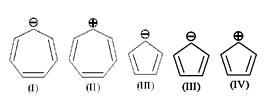Which one of the following oxides is expected to exhibit paramagnetic behaviour?
CO2
SO2
ClO2
SiO2
The correct Answer is:C
To determine which oxide exhibits paramagnetic behavior, we need to analyze the valence electrons of each compound and check for the presence of unpaired electrons. Paramagnetic substances have unpaired electrons, while diamagnetic substances have all paired electrons.
1. Identify the Oxides: The options given are:
- A) CO2 (Carbon Dioxide)
- B) SO2 (Sulfur Dioxide)
- C) ClO2 (Chlorine Dioxide)
- D) SiO2 (Silicon Dioxide)
2. Count the Valence Electrons:
- For CO2:
- Carbon (C) has 4 valence electrons.
- Oxygen (O) has 6 valence electrons, and there are 2 oxygen atoms.
- Total = 4 + (6 × 2) = 4 + 12 = 16 electrons (even).
- For SO2:
- Sulfur (S) has 6 valence electrons.
- Oxygen (O) has 6 valence electrons, and there are 2 oxygen atoms.
- Total = 6 + (6 × 2) = 6 + 12 = 18 electrons (even).
- For ClO2:
- Chlorine (Cl) has 7 valence electrons.
- Oxygen (O) has 6 valence electrons, and there are 2 oxygen atoms.
- Total = 7 + (6 × 2) = 7 + 12 = 19 electrons (odd).
- For SiO2:
- Silicon (Si) has 4 valence electrons.
- Oxygen (O) has 6 valence electrons, and there are 2 oxygen atoms.
- Total = 4 + (6 × 2) = 4 + 12 = 16 electrons (even).
3. Determine Magnetic Behavior:
- CO2: 16 electrons (even) → Diamagnetic.
- SO2: 18 electrons (even) → Diamagnetic.
- ClO2: 19 electrons (odd) → Contains unpaired electrons → Paramagnetic.
- SiO2: 16 electrons (even) → Diamagnetic.
4. Conclusion: The oxide that exhibits paramagnetic behavior is C) ClO2.
- A) CO2 (Carbon Dioxide)
- B) SO2 (Sulfur Dioxide)
- C) ClO2 (Chlorine Dioxide)
- D) SiO2 (Silicon Dioxide)
- For CO2:
- Carbon (C) has 4 valence electrons.
- Oxygen (O) has 6 valence electrons, and there are 2 oxygen atoms.
- Total = 4 + (6 × 2) = 4 + 12 = 16 electrons (even).
- For SO2:
- Sulfur (S) has 6 valence electrons.
- Oxygen (O) has 6 valence electrons, and there are 2 oxygen atoms.
- Total = 6 + (6 × 2) = 6 + 12 = 18 electrons (even).
- For ClO2:
- Chlorine (Cl) has 7 valence electrons.
- Oxygen (O) has 6 valence electrons, and there are 2 oxygen atoms.
- Total = 7 + (6 × 2) = 7 + 12 = 19 electrons (odd).
- For SiO2:
- Silicon (Si) has 4 valence electrons.
- Oxygen (O) has 6 valence electrons, and there are 2 oxygen atoms.
- Total = 4 + (6 × 2) = 4 + 12 = 16 electrons (even).
- CO2: 16 electrons (even) → Diamagnetic.
- SO2: 18 electrons (even) → Diamagnetic.
- ClO2: 19 electrons (odd) → Contains unpaired electrons → Paramagnetic.
- SiO2: 16 electrons (even) → Diamagnetic.
Similar Questions
Knowledge Check
Which one of the following oxides is neutral ?
ASrOBAI2O3CCO2DCO
which one of the following oxides is neutral?
View SolutionWhich one of the following is an oxide ?
View SolutionWhich one of the following complex is not expected to exhibit isomerism
View SolutionWhich of the following complexes exhibits the highest paramagnetic behaviour?
where gly=glycine, en=ethylenediamine and bipy =bipyridyl
(At. no. Ti=22,V=23,Fe=26,Co=27)
View SolutionThe d-electron configurations of Cr2+,Mn2+,Fe2+ and Co2+ are d4,d5,d6 and d7 respectively. Which one of the following will exhibit minimum paramagnetic behaviour?
View SolutionWhich of the following complex species is not expected to exhibit optical isomerism ?
View SolutionWhich of the following species would be expected to exhibit aromatic character?

View Solution
